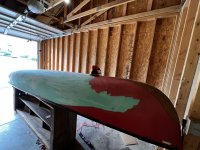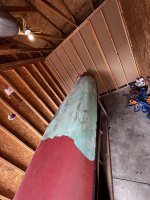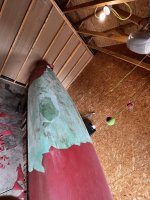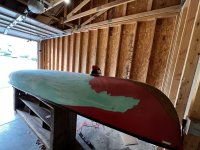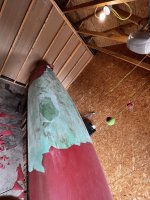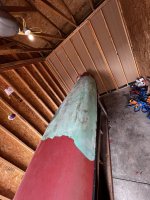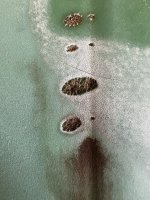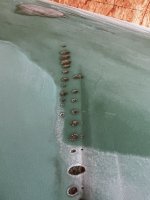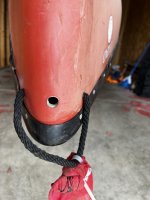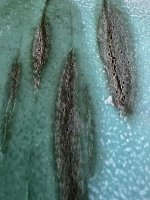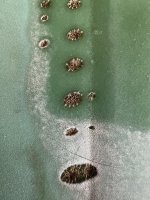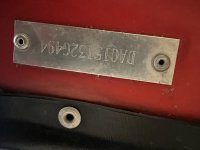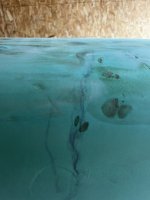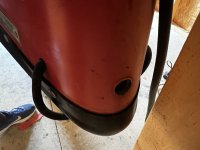“
What holes in particular are you talking about? The ones on the ends of the stems? Those are the only holes that I see that would likely reach the foam core. I'm certain that your eye sees something that I don't”
The big drilled holes in the stems are (old school were) a different way of drilling drain holes. Instead of drilling drain holes at the tips of the deck plates some folks drilled holes centered on the stems an inch or two below the tip. Ugly, but a wide enough hole there kept small debris from lodging under the deck plate tips and eventually falling out looking like a sodden mouse nest.
I wouldn’t plug them; you’ll want drain holes and they are already there. At most I might paint a little epoxy on the exposed foam core inside the holes.
“How
much S Fiberglass would you recommend purchasing for a project like this?”
If the bottom feel, stiff enough I’m not sure you need any. Laying large pieces, or even smaller partials, of glass fabric gets into trickier business, and additional expense, sanding, top coating, release treated peel ply if you think ahead.
If the bottom seems firm you should be able to make a quite serviceable canoe for less than $200, with some materials left over; although the Post-it Note ease of peeling the outer vinyl skin is a bit worrisome, or at least never-before-seen peculiar.
G/flex 650 is always handy to have around; with proper prep it sticks to dang near everything, and at a 50/50 mixing ratio is it is easy to eyeball pea sized amounts for niggling household repairs.
I’m kinda guessing here, never covered large expanses of peeled-vinyl exposed ABS, but if you don’t need to do any major fiberglass repairs I’d go straight G/flex 650 on the exposed ABS layers, and lap that a bit onto any intact vinyl. Not cheap, but I wouldn’t go cheap there, and 32oz should be enough, or more than enough.
G/flex epoxy, even G/flex mixed in some proportion with West 105/206, is your friend in Royalexy-flexy repairs. Note here below that West System recommends “
Alcohol wipe, flame treat” for ABS (Royalex).
https://www.westsystem.com/specialty-epoxies/gflex-epoxy-adhesion-data/
The “flame treat” is nothing more than briefly running the blue tongue of a propane torch along the area immediately before using G/flex. It doesn’t even need to be hot, just a brief lick of blue flame.
What Pblanc said about painting with EZ-Pozy. Or, actually rolling and tipping with EZ-Poxy.
There are other, usually 2-part paints, that are better. And pricier. There are some topside paints, not
quite as good, but a lot cheaper than EZ-poxy ($55 quart). Rustoleum Topside is $18 a quart. A quart is enough to lay down three coats, and the second and third coats will only look better when you have practice rolling and tipping out.
I would usually recommend selecting a paint that matches the hull color, but with the missing vinyl skin I dunno. Go crazy; maybe a Dazzle scheme.
https://en.wikipedia.org/wiki/Dazzle_camouflage
Or something patriotic
https://pixels.com/featured/patriotic-canoe-2-red-white-blue-nikolyn-mcdonald.html
And, not to harp on it, but you will save yourself a lot of wasted time and effort with a set of sawhorses. Even cheap, compact folding sawhorses.
https://www.homedepot.com/b/Tools-Tool-Storage-Saw-Horses/N-5yc1vZc708
At some point you will need to turn the canoe right side up. That will not be much fun with it balanced wobbling precariously atop a dresser, needing a stepstool just to peer inside.
I am understandable curious about how it turns out, please keep us posted.

